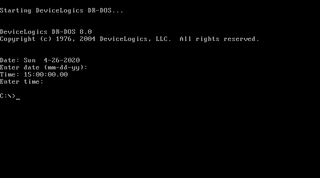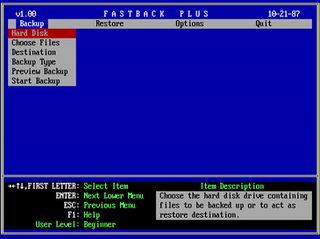"Abort, Retry, Fail?" is an error message found in DOS operating systems, which prompts the end-user for a course of action to follow. Although welcomed by some, the message also has been cited as an example of poor usability in computer user interfaces.
 W
WCP/M, originally standing for Control Program/Monitor and later Control Program for Microcomputers, is a mass-market operating system created in 1974 for Intel 8080/85-based microcomputers by Gary Kildall of Digital Research, Inc. Initially confined to single-tasking on 8-bit processors and no more than 64 kilobytes of memory, later versions of CP/M added multi-user variations and were migrated to 16-bit processors.
 W
WIn computing, BIOS is firmware used to perform hardware initialization during the booting process, and to provide runtime services for operating systems and programs. The BIOS firmware comes pre-installed on a personal computer's system board, and it is the first software to run when powered on. The name originates from the Basic Input/Output System used in the CP/M operating system in 1975. The BIOS originally proprietary to the IBM PC has been reverse engineered by some companies looking to create compatible systems. The interface of that original system serves as a de facto standard.
 W
WA COM file is a type of simple executable file. On the Digital Equipment operating systems of the 1970s, .COM was used as a filename extension for text files containing commands to be issued to the operating system. With the introduction of CP/M, the type of files commonly associated with COM extension changed to that of executable files. This convention was later carried over to DOS. Even when complemented by the more general EXE file format for executables, the compact COM files remained viable and frequently used under DOS.
 W
WA COM file is a type of simple executable file. On the Digital Equipment operating systems of the 1970s, .COM was used as a filename extension for text files containing commands to be issued to the operating system. With the introduction of CP/M, the type of files commonly associated with COM extension changed to that of executable files. This convention was later carried over to DOS. Even when complemented by the more general EXE file format for executables, the compact COM files remained viable and frequently used under DOS.
 W
W4DOS is a command-line interpreter by JP Software, designed to replace the default command interpreter COMMAND.COM in Microsoft DOS and Windows. It was written by Rex C. Conn and Tom Rawson and first released in 1989. Compared to the default, it has a large number of enhancements.
 W
WDR-DOS is an operating system of the DOS family, written for IBM PC-compatible personal computers. It was originally developed by Gary A. Kildall's Digital Research and derived from Concurrent PC DOS 6.0, which was an advanced successor of CP/M-86. As ownership changed, various later versions were produced with names including Novell DOS and Caldera OpenDOS.
 W
WIn computer data storage, drive letter assignment is the process of assigning alphabetical identifiers to volumes. Unlike the concept of UNIX mount points, where volumes are named and located arbitrarily in a single hierarchical namespace, drive letter assignment allows multiple highest-level namespaces. Drive letter assignment is thus a process of using letters to name the roots of the "forest" representing the file system; each volume holds an independent "tree".
 W
WFastBack is a software application developed in the late 1980s and early 1990s for backing up IBM PC and Macintosh computers. It was originally written by Fifth Generation Systems, a company located in Baton Rouge, Louisiana. When the company wanted to expand into the Apple market they purchased and rebranded a product from TouchStone Software Corporation.
 W
W4DOS is a command-line interpreter by JP Software, designed to replace the default command interpreter COMMAND.COM in Microsoft DOS and Windows. It was written by Rex C. Conn and Tom Rawson and first released in 1989. Compared to the default, it has a large number of enhancements.
 W
WDR-DOS is an operating system of the DOS family, written for IBM PC-compatible personal computers. It was originally developed by Gary A. Kildall's Digital Research and derived from Concurrent PC DOS 6.0, which was an advanced successor of CP/M-86. As ownership changed, various later versions were produced with names including Novell DOS and Caldera OpenDOS.
 W
WMSCDEX or Microsoft CD-ROM Extensions is a software program produced by Microsoft and included with MS-DOS 6.x and certain versions of Windows to provide CD-ROM support. Earlier versions of MSCDEX since 1986 were installable add-ons for MS-DOS 3.1 and higher.
 W
WDR-DOS is an operating system of the DOS family, written for IBM PC-compatible personal computers. It was originally developed by Gary A. Kildall's Digital Research and derived from Concurrent PC DOS 6.0, which was an advanced successor of CP/M-86. As ownership changed, various later versions were produced with names including Novell DOS and Caldera OpenDOS.
 W
WDR-DOS is an operating system of the DOS family, written for IBM PC-compatible personal computers. It was originally developed by Gary A. Kildall's Digital Research and derived from Concurrent PC DOS 6.0, which was an advanced successor of CP/M-86. As ownership changed, various later versions were produced with names including Novell DOS and Caldera OpenDOS.
 W
WIn computing, redirection is a form of interprocess communication, and is a function common to most command-line interpreters, including the various Unix shells that can redirect standard streams to user-specified locations.
 W
WDR-DOS is an operating system of the DOS family, written for IBM PC-compatible personal computers. It was originally developed by Gary A. Kildall's Digital Research and derived from Concurrent PC DOS 6.0, which was an advanced successor of CP/M-86. As ownership changed, various later versions were produced with names including Novell DOS and Caldera OpenDOS.